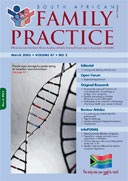Paraffin poisoning in children: What can we do differently?
Abstract
Background: The purpose of this study was to describe the occurrence, health cost and management of paraffin poisoning in a rural South African hospital. Methods: A retrospective study was undertaken of 145 children admitted with a diagnosis of paraffin poisoning at Philadelphia Hospital, Mpumalanga from January 2000 to June 2001. A pre-tested form was used to collect data from the admission files. Where applicable, the Chi-square test or t-test was used to determine statistical significance. Results: Children younger than five years of age were affected significantly more than those older than five years of age (91% vs. 9%, p<0.001), and boys were affected more than girls (58% vs. 42%, p=0.034). The average length of stay and cost of treatment were 2.5±2 days and R617.24 respectively. Prophylactic antibiotics were prescribed in 86% of cases (125/145) and the average number of medications prescribed per child was 3.5±1.8. Conclusions: Although no mortality was reported, paraffin poisoning contributed substantially to the morbidity of, health expenditure for and antibiotic overuse in these children. Provision of child-resistant paraffin container caps, retraining of doctors on appropriate antibiotic use and community education are necessary and crucial in reducing the occurrence of paraffin poisoning in children. (SA Fam Pract 2005;47(2): 54-56)
Published
2005-03-01
Section
Original Research
By submitting manuscripts to SAFP, authors of original articles are assigning copyright to the South African Academy of Family Physicians. Copyright of review articles are assigned to the Publisher, Medpharm Publications (Pty) Ltd, unless otherwise specified. Authors may use their own work after publication without written permission, provided they acknowledge the original source. Individuals and academic institutions may freely copy and distribute articles published in SAFP for educational and research purposes without obtaining permission.

